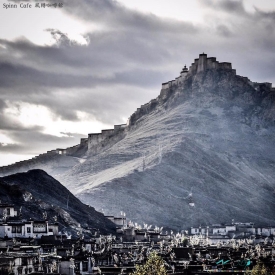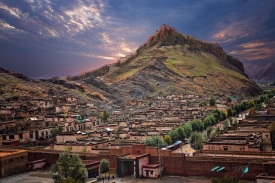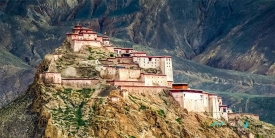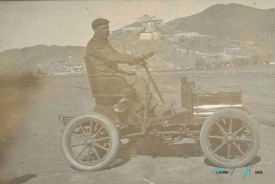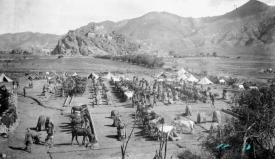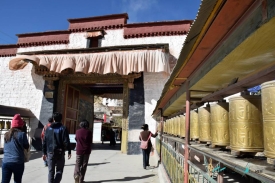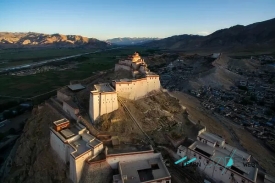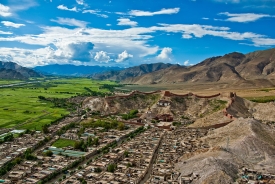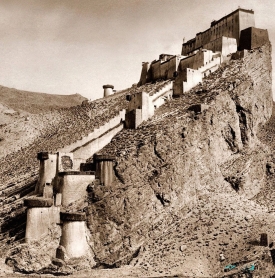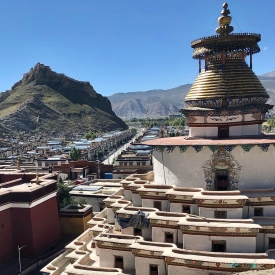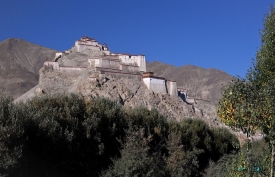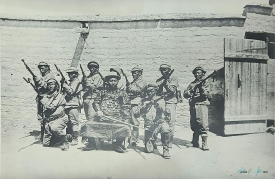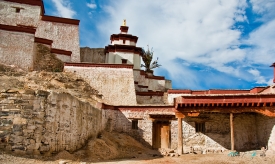The ancient castle of Gyantse Dzong is located on Zongshan Mountain in the urban area of Gyangze County, not far from Baiju Temple, and is especially spectacular from a distance below the mountain. This is the place where the Tibetan people fought against the invading British army in 1904, the location of Gyantse Dzong and the filming location for the movie "Red River Valley". Now it has been identified as a patriotic education base. The castle has exhibition rooms, such as a memorial that immortalizes the Tibetan warriors who preferred to jump off the cliff before surrendering to the invading army.
The castle retains many original Gyantse Dzong settings, such as the dungeons. In the permanent rooms of the castle we can glimpse the original appearance of Gyantse Dzong, when it was a feudal palace, and it reproduces how people lived in those times.
The construction of the original fortress, known as Gyel-khar-tse, is attributed to Pelkhor-tsen, son of Emperor Langdarma of the Yarlung dynasty (9th century) who continued to fight for dominance in western Tibet after the death of his father. the.
The current walls were supposedly built in the 13th century, after the rise to power of the Sakyapa sect.
Most of the surviving buildings of Gyantse Dzong were built in the early 14th century, and mainly include the Dzong (county magistrate's) office, scripture hall, Buddhist hall, and various storerooms, all built from the hillside of the Gyantse Dzong. the mountain to the top of the mountain along the mountain.
The monastic fortress became famous in 1904 as a defensive structure against British attack in the British campaign in Tibet under the command of Colonel Sir Francis Younghusband, who partially destroyed the castle, and the British managed to capture it. The heroic resistance of the defenders of the fort, against the British Empire, is mythologized by the Chinese Communist Party, which declared it a heroic site. Since 1961 it has been on the list of monuments of the People's Republic of China.
What the Chinese sources do not report is that the walls were dynamited by the Chinese in 1967 during the Cultural Revolution. That turbulent period has been erased from Tibetan history by the Chinese rulers.
The dzong has been gradually restored and still dominates the city and surrounding plains as it always did. There is now a small museum depicting the excesses of the Younghusband expedition from the Chinese perspective.
The castle retains many original Gyantse Dzong settings, such as the dungeons. In the permanent rooms of the castle we can glimpse the original appearance of Gyantse Dzong, when it was a feudal palace, and it reproduces how people lived in those times.
The construction of the original fortress, known as Gyel-khar-tse, is attributed to Pelkhor-tsen, son of Emperor Langdarma of the Yarlung dynasty (9th century) who continued to fight for dominance in western Tibet after the death of his father. the.
The current walls were supposedly built in the 13th century, after the rise to power of the Sakyapa sect.
Most of the surviving buildings of Gyantse Dzong were built in the early 14th century, and mainly include the Dzong (county magistrate's) office, scripture hall, Buddhist hall, and various storerooms, all built from the hillside of the Gyantse Dzong. the mountain to the top of the mountain along the mountain.
The monastic fortress became famous in 1904 as a defensive structure against British attack in the British campaign in Tibet under the command of Colonel Sir Francis Younghusband, who partially destroyed the castle, and the British managed to capture it. The heroic resistance of the defenders of the fort, against the British Empire, is mythologized by the Chinese Communist Party, which declared it a heroic site. Since 1961 it has been on the list of monuments of the People's Republic of China.
What the Chinese sources do not report is that the walls were dynamited by the Chinese in 1967 during the Cultural Revolution. That turbulent period has been erased from Tibetan history by the Chinese rulers.
The dzong has been gradually restored and still dominates the city and surrounding plains as it always did. There is now a small museum depicting the excesses of the Younghusband expedition from the Chinese perspective.



